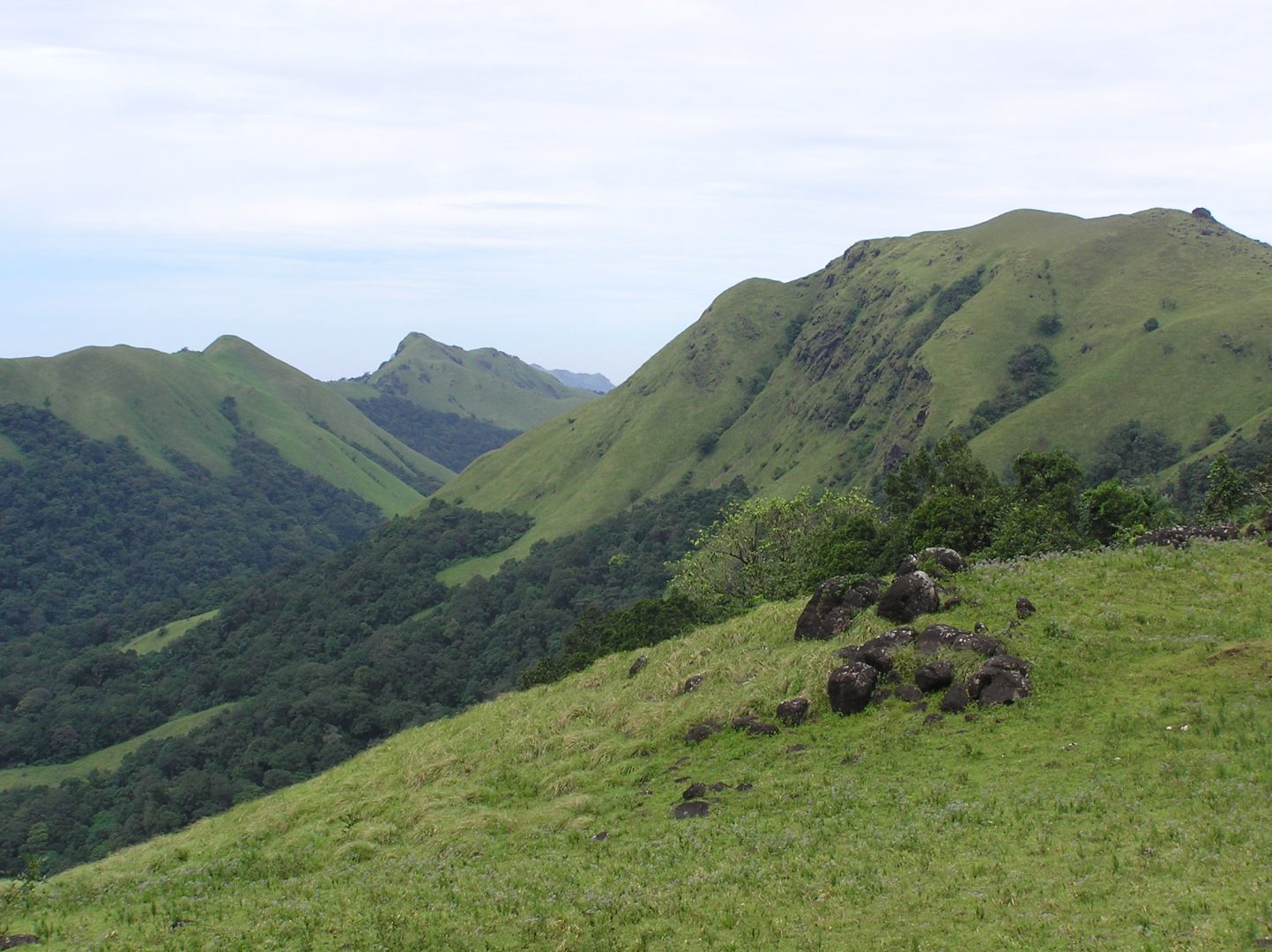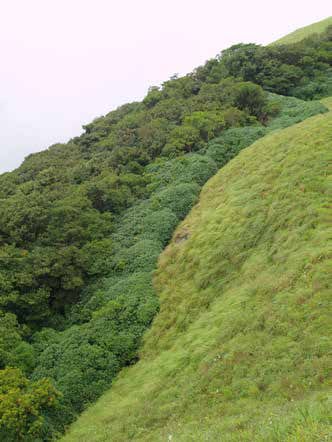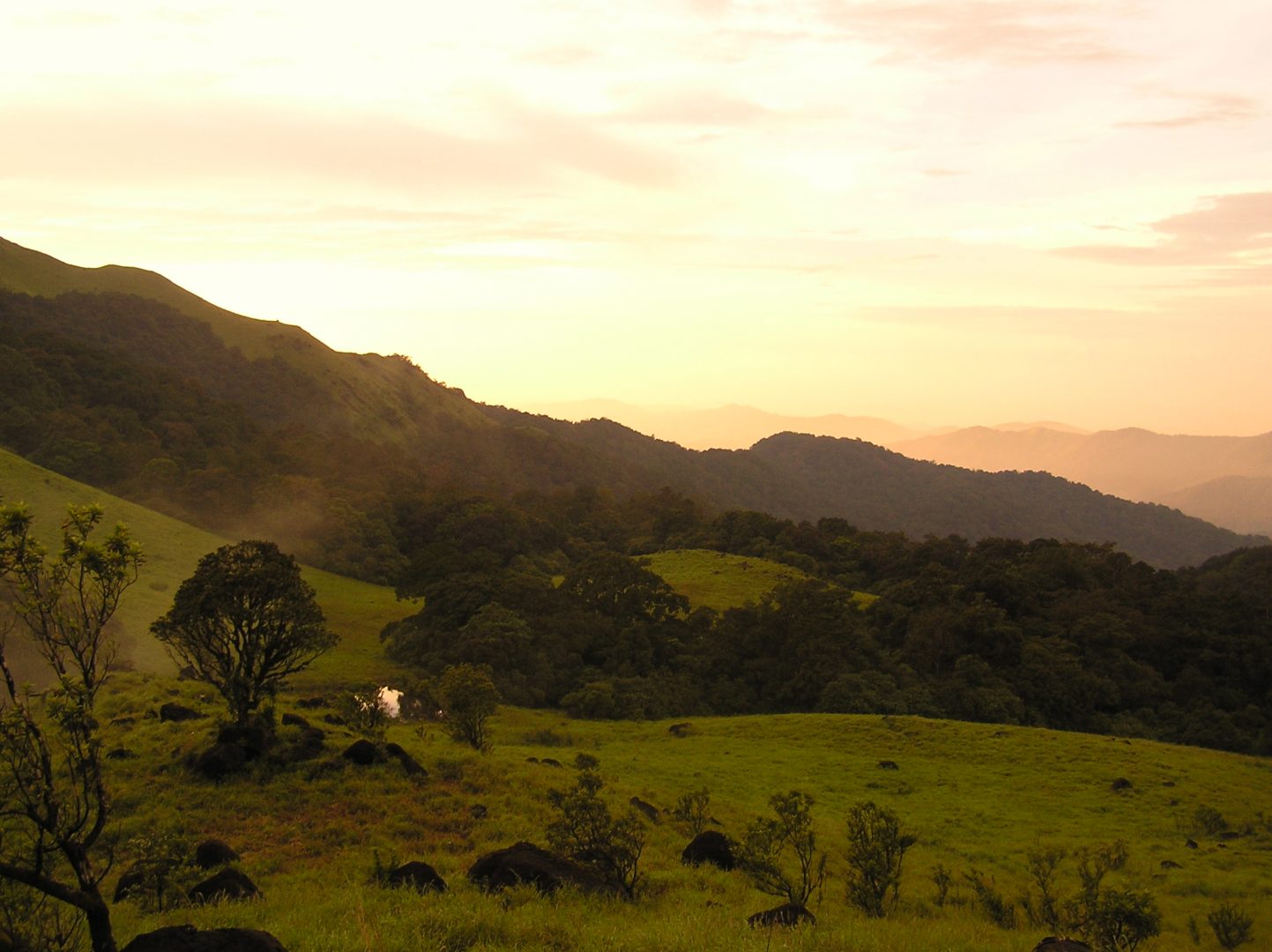Walking along a narrow strip of forest and ducking overhanging branches covered in a thick layer of moss, I took a rattling breath that filled my lungs with water droplets. Heading up the misty mountains without adequate warm clothing was not one of my better decisions. As I peered ahead into the lightening gloom, I could see the trees were thinning out. One last duck, and there was the view I wanted: rolling grassland. Kilometres of gently undulating grassy slopes, the occasional lone tree, and forest clumps in the valleys between mountains.
This habitat, called the shola-grassland mosaic, is found on the mountaintops of the Western Ghats of southern India, a mountain range parallel to the west coast of the country. “Shola” is the word for “forest” or “grove” in Tamil, one of the main languages spoken in southern India. The elevation above which this habitat is found varies from as low as 1050 metres to above 1700 metres. This depends on how isolated a particular mountaintop is, and its distance from the coast. The climate in the upper altitudes, and hence the vegetation, is entirely different from what is found in the lower elevations, just a few kilometres down the mountainside. Shola-grassland ecosystems are thus “sky islands”—habitats that include a chain of mountains and valleys, with the mountaintops akin to “islands” of different vegetation in an “ocean” of valleys.
The shola
The forests that grow in clumps in the valleys of the hills have a distinctive appearance: stunted trees of about 16-20 metres in height, close growing in such a manner that the branches of neighbouring trees interlock. These branches are usually laden with epiphytes—plants like orchids and mosses that grow on larger plants—making the shade underneath almost impenetrable.
Trees of the genus Rhododendron are an excellent example of temperate species having established themselves in a tropical mountain. Botanists first encountered one species of Rhododendron in the Western Ghats, one in Sri Lanka, and a burst of about 87 in the Himalayas. The initial guess was that the Western Ghats and Sri Lankan species would be different from the Himalayan species, given the thousands of kilometres that separate them. Recent studies have shown that the Western Ghats species Rhododendron nilagiricum is technically Rhododendron arboretum subsp nilagiricum—a subspecies of R arboretum, a widespread Himalayan species. The tree genus Pedicularis also has many species in the Himalayan meadows, but only two from the Western Ghats sholas— Pedicularis perrotettii and P. zeylanica, as the name indicates, is also found in the sky islands of Sri Lanka.

Dr Meher Homji from the French Institute, Pondicherry, observed something fascinating about these forest clumps. Their interiors contain species that are tropical in origin, i.e. most of their relatives are found in tropical areas, in this case from Western Ghats and Sri Lanka, or the Indo-Malayan region (South-East Asia). These belong to the plant families Lauraceae, Rubiaceae, Symplocaceae and Myrtaceae. Closer to the edge of these forest clumps, in the areas exposed to the surrounding grassland, the species found are not tropical (as one would expect so close to the equator), but temperate in origin.
This fascinating similarity between the sky islands of Western Ghats and Himalayan vegetation, thousands of kilometres away, has intrigued biologists for many decades. Sunder Lal Hora, a fish biologist who was studying fish living in torrential streams, came up with the most influential hypothesis: there was a once continuous corridor of tropical evergreen forests from the Himalayas of Northeast India and the Western Ghats, via the Vindhya and Satpura ranges of Central India. From 2.5 million years ago to about 11,000 years ago during the Quarternary period, the earth as a whole experienced cycles of dry and wet periods; in India especially, evidence shows that certain tracts of northern India were much wetter than they are today. There is also evidence that at around the same time, large tracts of India were much colder than what they are now, allowing some temperate Himalayan species to reach the Western Ghats. Some lived on in the cold shola grasslands; other species that ended up at lower elevations would probably have died out, after India warmed up to how it is now. The Himalayan species could tolerate the ground frost in the open grasslands much better than the “tropical” species that are found inside the shola forests.
The grasslands
Strobilanthes kunthiana, or “neelakurinji” in Tamil, is a strange plant. It grows in large clumps wherever it can, in the grasslands of the sky islands. Once in 12 years, all the plants flower together, set seed and die. When they flower, entire hillsides transform into a blue carpet. This is what prompted the name Nilgiris, or Blue Mountains (“Nil”–blue, “giris”–mountains). When these plants flower, bees and other insects delight in the rich nectar; when the flowers eventually set fruit, they form rice-like seed that makes rats and other rodents go into a feeding frenzy. However, there are so many seeds that enough survive the rodents, and start growing after the next rains. They remain unremarkable, small green bushes until 12 years after, when they flower and transform the mountains again.
The S. kunthiana flowering is a dramatic event, but the grasslands boast of a bewildering variety of plants. For instance, a rapid assessment of the Mukurthi National Park in the Nilgiris range by a team from Gurukula Botanical Sanctuary came up with an astonishing 198 species from just 77 square kilometres. Some species form mats so dense that no ground can be seen; others grow in patches on hilltops, and still others tolerate fire events and sprout back after a shower. Some species colonise marshes, and others grow on seemingly inhospitable vertical rock faces.
The community composition of the grassland was found to be strongly related to environmental and soil factors, like depth of soil, presence or absence of rocks and boulders, grazed and/or burnt conditions, forest-grassland edges and rocky or nonrocky slopes. Like the Himalayan affinity seen among the shola forests, the grasslands have grass and herb genera that are largely found in temperate areas, like Gentiana, Senecio, Rubus, Potentilla and Geranium.

The genus Impatiens, much cherished in gardens as the popular balsams, have about a hundred known species in the Western Ghats. Some balsams seem to grow out of sheer rock, with nothing but the beautiful flower to mark the plant; some are found near streams, some in marshes, and some are small shrubs along the roadside. After being pollinated, the pod like fruit bursts open when ripe, spewing out seeds in a mini explosion that can feel very powerful in the palm of your hand. Now you know why they’re called Impatiens.
The animals
Perched on one such grassland top in Meesapuli malai in Munnar, a friend and I spotted sudden movement on the adjacent mist-covered hilltop. A herd of tahr leapt gracefully across a craggy, impossibly steep slope with all the grace in the world. Somehow, they could sense our eyes on them, though we were separated by a deep valley unsuited for booted humans, but akin to a highway to the agile mountain goat.
The Nilgiri tahr, Niligiritragus hylocrius, is endemic to the sky islands of the Western Ghats. Its nearest relative is away in the Himalayas, adding to the list of interesting relationships between species separated by thousands of kilometres. The Nilgiri tahr is critically endangered now, with isolated populations in the Anamalais and Nilgiris the last stronghold for this iconic species.

Apart from the Tahr, the high mountains are also home to the elusive Nilgiri marten and the critically endangered Nilgiri langur, whose distinctive whooping calls occasionally pierce the silence of the sky islands, rolling in with the mist. On Chemmunji peak in Peppara Wildlife Sanctuary in the South Indian state of Kerala, one is certain to find herds of gaur grazing near the hut that accommodates trekkers, in this area, which is rightly called “Abode of the Gaur”. Tigers and the wild dog, dhole, can also be seen in the sky islands.
Recent research has been proving the existence of species as yet unknown to us from these sky islands. Since each island is separated from others by valleys of unsuitable climate and vegetation, species that cannot move too much, like frogs, become isolated in these islands over millions of years—there is room for many new species to be discovered in this landscape.
The sky island environment
Most rainfall here is from the Indian monsoons. The southwest monsoon between April and September gives variable rain across the sky islands, in some areas as much as 7000 mm. Because of the geographic orientation of the Ghats, the western slopes, rather than the eastern slopes, receive most of the southwest monsoon rainfall. The eastern slopes receive rainfall from the northeast monsoon and from cyclonic storms in the Bay of Bengal.
The soil from the grasslands is calcium-deficient, derived from parent rocks, which are usually gneiss, charnockites and schists. Typically, the soil is shallower in grasslands than in shola forests; this, combined with a lack of shade, makes it more prone to moisture loss. During the dry season, shola soils have been shown to retain about twice as much moisture as that accumulated in the surrounding grasslands.
The shola forests provide cover and reduce erosion of soils under them. The net amount of precipitation under the shola canopy is indiscriminately high—apart from rainfall, the forests also sequester wind-driven fog onto tree crowns. The forests act as sponges that soak up all forms of precipitation, which is then released as mountain streams that coalesce to form the headwaters of all major rivers originating in the Western Ghats.
A dual climax
Analysis of peat samples from shola fragments in the Nilgiris show that shola and grasslands have undergone cyclical shifts in dominant vegetation type. Raman Sukumar and others found that pollen preserved in peat in the high altitude areas of the Nilgiris provided excellent resolution of past climatic events. Grasses dominated 20,000- 16,000 years ago during an arid period. This was followed by a wetter phase, around 12,000 years ago, which ushered in an age where the shola forests were dominant. Around 6000 years ago, the monsoon weakened, resulting in a drier period where grasses dominated once again; this is approximately what we see today.
There have been many theories about why grasslands and forests exist side-by-side in such a manner, over time. Existence of such “alternate stable states” has been shown theoretically using modelling exercises, but not with actual data from field observations, says Mahesh Sankaran from the National Centre for Biological Sciences, who researches grassland-forest dynamics. “Whether or not the shola-grassland mosaic actually represents a dual climax is unknown. Even if there was such a state, whether the factors responsible are fire, or herbivory, or frost, is as yet unknown.”

He further adds, “We must remember that the sholas typically occur in certain kind of areas in this mosaic, like valley depressions and along streams. This raises the question, Do these areas represent a fundamentally different environment from the grasslands? In that case, they probably do not represent ‘alternate’ states. A way to test this would be to prevent all kinds of external forces from acting upon a shola-grassland system, i.e. experimentally change any/all of the suspected triggers—would the grassland switch to a forested state?” Only further research can solve this intriguing puzzle.
People
The first human occupation of the Western Ghats region occurred around 12,000 years ago during the late Paleolithic. The first signs of agri-pastoralism date to around 3000 to 5000 years ago. We don’t know much about the early settlers or their origins. Some studies have speculated that the Harappan people from the ancient Indus Valley Civilisation, which extended from what today is northwestern India, Pakistan and Afghanistan, migrated southward to the hills. Today, we see a variety of tribes, such as the Kani in the southernmost Agastyamalai hills, the Koravas in the Anamalai hills and the Todas and Badagas in the Nilgiris.
The British rule abolished slash-and-burn cultivation, and began large-scale commercial plantations of cash crops, including different species of eucalyptus, acacia and pine across most areas, and tea in the higher elevations. Their idea was to replace what they considered unproductive grasslands, and tracts of slow-growing shola forests, with fast growing, economically useful species. Post-independence, plantation programmes also received national budgetary support, to feed timber and pulp industries. Settlements in the hills have also increased, with fruit orchards and vegetable gardens replacing both shola and grassland.
Collection of small timber from the sholas, destruction of the shola-grassland habitat and an increase in invasive species like Eupatorium glandulosum and Ulex europaeus have together resulted in about 30 grassland species being categorised as endangered in Eravikulam National Park, and about 70 rare or threatened species in the Palanis.

Conservation
The red-disc bush brown is a butterfly species that lives only in the shola-grassland mosaic of southern Western Ghats, and nowhere else in the world. In a recent study, researchers have shown that the butterfly is finding it difficult to navigate the “valley” between two adjoining sky island complexes—the Munnar area to the west of the Ghats and the Kodaikanal area to the east of the Ghats. The approximately 50-kilometres wide “valley” has higher temperatures and lower rainfall than the sky islands on either side.
Across the same landscape, the white-bellied shortwing, a bird found only in the shola forests of the Western Ghats, has been changing the way it sings. Robin Vijayan and his colleagues have been working on this bird for a few years, and they have recorded birds calling from different forest patches. Birdsong is something chicks learn from parent birds. The isolation of birds into their own forest patches is causing them to develop dialects distinct from those in other forest patches; and since birds are not flying between the forests, the different dialects are not mixing, and their songs are growing more and more different from each other.
These studies are just the beginning, indicating the great extent to which disturbance is affecting this fragile, breathtaking habitat. After the centuries old history of intensive management and land use practices, which began during the British rule, and has been continued, we will never really know how they would have been in all their glory. Travelling in Munnar and Kodaikanal during the last mass flowering of Strobilanthes kunthiana in 2006, I could see isolated patches of blue. Traditionally, the bush would have covered the hillside forming continuous blue carpets. Now invasive bushes like bracken have taken over the space that S. kunthiana would have occupied, making them a figment of my imagination, brought to life after reading descriptions, some as old as ancient Tamil literature. Judging from these sources—and the fact that the entire Nilgiris was named after the blue buds of a single flowering bush—the unspoiled mountains must have been something remarkable. Whether the next generation even sees a fraction of the sky islands’ isolated beauty is truly in our hands.
Further reading:
Bunyan M, S Bardhan & S Jose. 2012. The Shola (Tropical Montane Forest)-Grassland Ecosystem Mosaic of Peninsular India: A Review. American Journal of Plant Sciences, 3, 1632-1639.
Sukumar R, R Ramesh, RK Pant & G Rajagopalan. 1993. A δ13C record of late Quaternary climate change from tropical peats in southern India. Nature, 364: 703-706.
Photographs: Ullasa Kodandaramaiah, Kalyan Varma, Kartik Shanker






